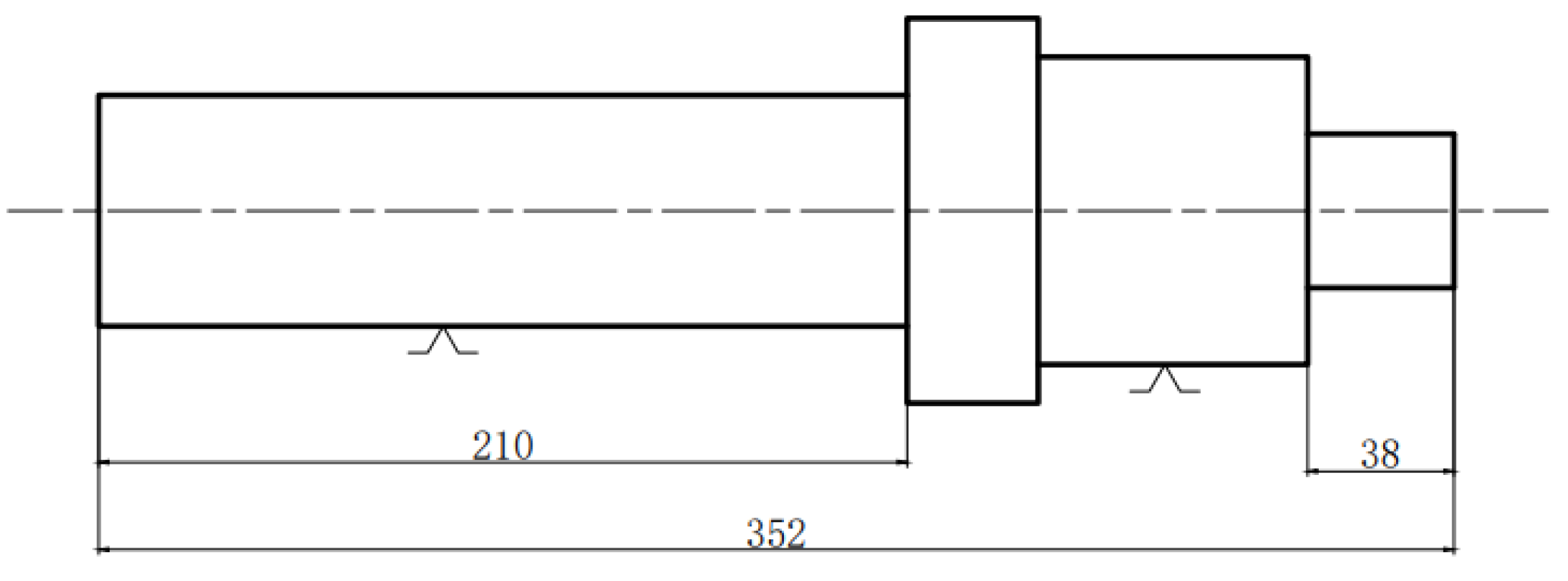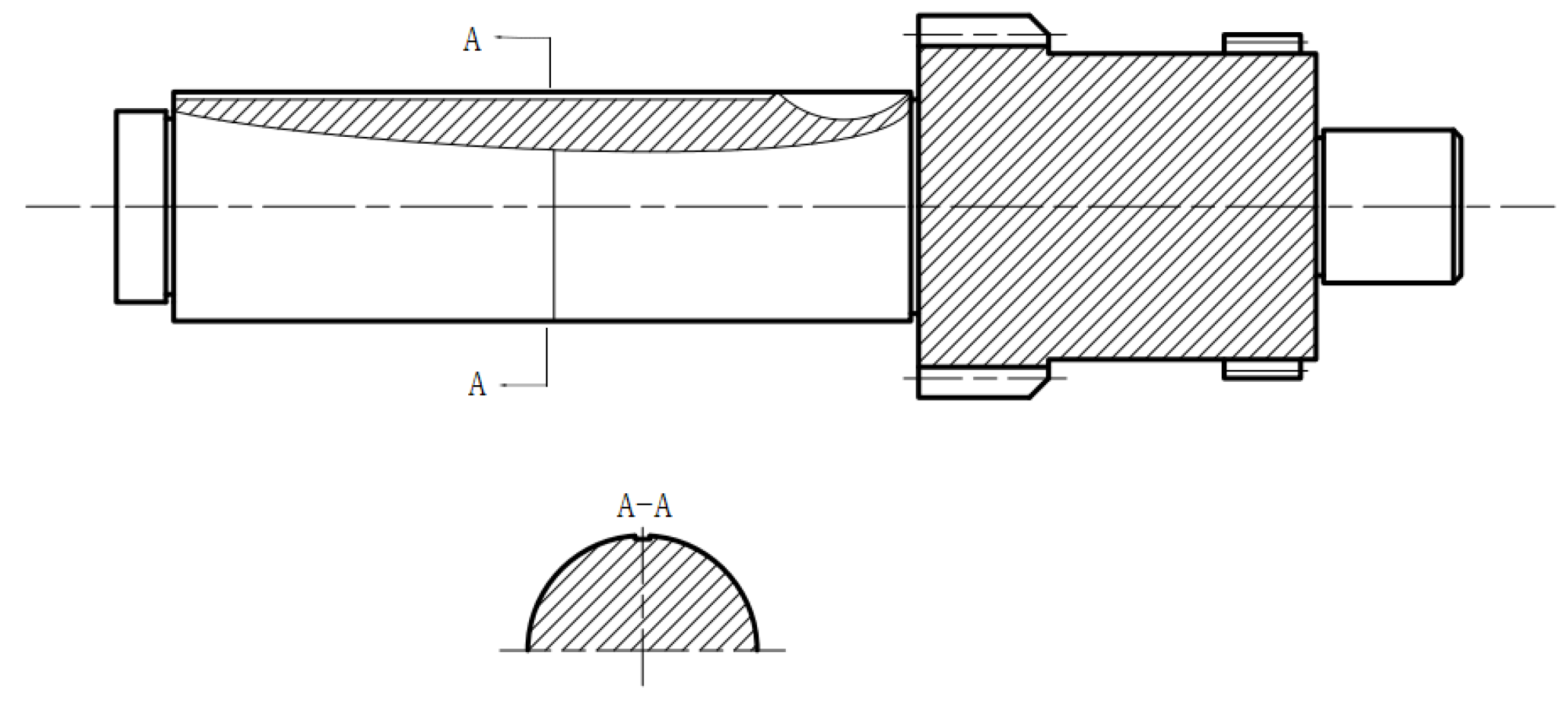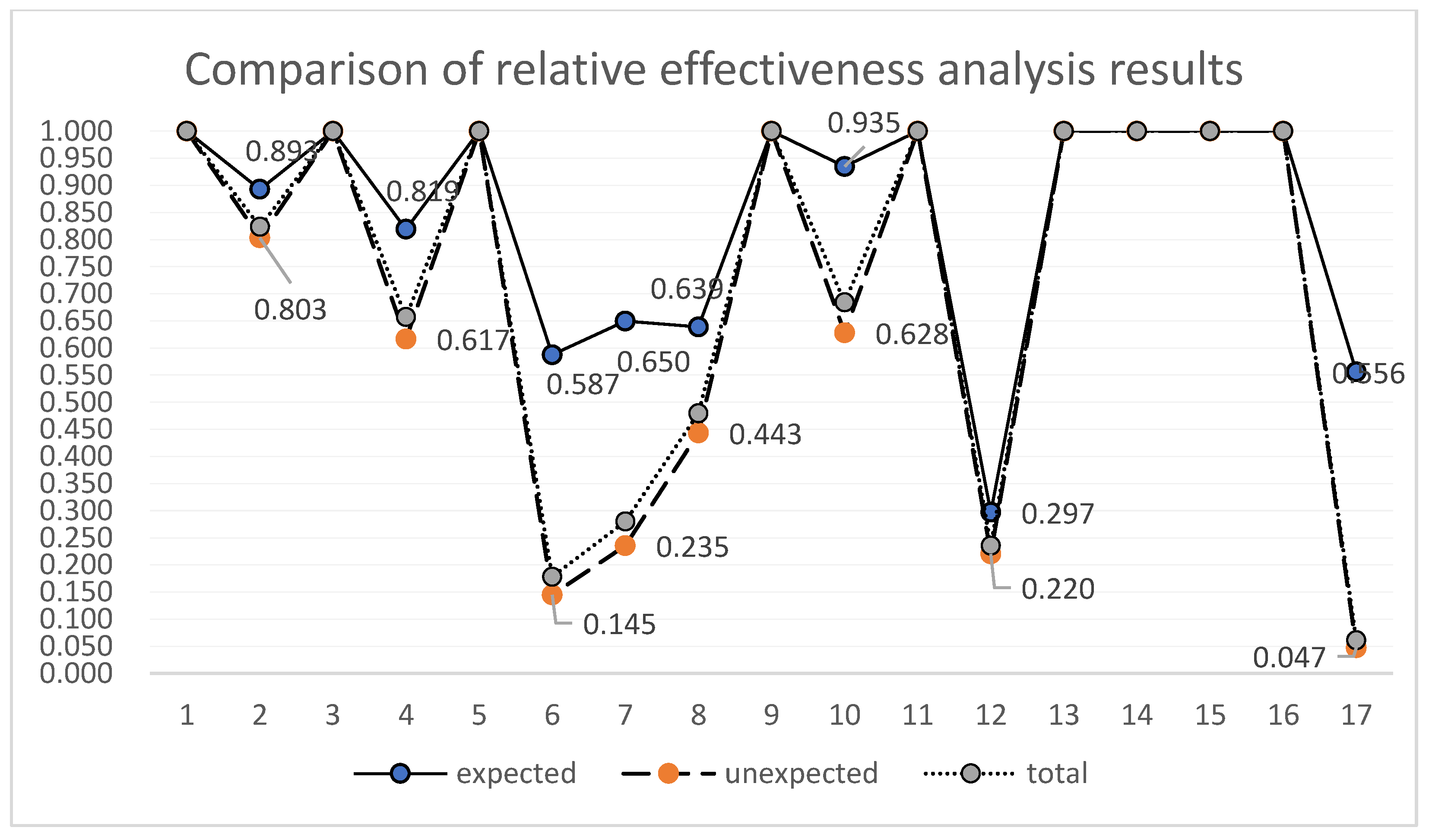Evaluation of Resource Utilization Efficiency in the Machining Process Based on the SBM-DEA Model with Non-Expected Output
Abstract
1. Introduction
2. Resource Utilization Efficiency Evaluation Method
2.1. Traditional DEA Model—CCR Model
2.2. DEA Model with Unexpected Output
2.3. SBM—DEA with Unexpected Output
3. Resource Utilization Efficiency of the Machining Process
3.1. Evaluation Model of Resource Utilization in the Machining Process
3.2. Quantitative Model of Input and Output
- (1)
- Process basic information, process conditions, and procedure acquisition methods
- (2)
- Quantification of input indicators
- (3)
- Quantification of output indicators
- (4)
- Quantification of cutting fluid: Obtained by multiplying the jet flow rate of the cutting fluid with the processing time, as shown in Equation (12).
- (5)
- Quantification of waste: used an electronic scale to measure the weight before and after the process started, and then the two values were subtracted.
4. Case Study
4.1. Basic Information about the Case
4.2. Data Processing and Analysis
4.3. Results and Discussion
5. Conclusions
- (1)
- A DEA model can be used to comprehensively consider the input resources, expected output, and non-expected output that affect the machining process. To overcome the existing research, only single factors such as energy consumption ratios, raw material inputs, etc.
- (2)
- By using the SBM-DEA with unexpected output model, the efficiency value of this model can accurately reflect the resource utilization efficiency of each process, and provide managers with a breakthrough to improve the utilization efficiency of process resources and corresponding feasible plans.
- (3)
- Based on the DEA evaluation model, the resource utilization efficiency of each process can be quantitatively analyzed and compared. Reduce the interference of subjective factors and ensure the objectivity of efficiency evaluation and measurement. It provides a feasible way to improve the resource utilization efficiency of the machining process.
Author Contributions
Funding
Institutional Review Board Statement
Informed Consent Statement
Data Availability Statement
Conflicts of Interest
Abbreviations
| input indexes, | |
| output indexes, . | |
| infinitesimal. | |
| s− | slack variables representing the input redundancy. |
| s+ | slack variables representing the output deficiency. |
| unexpected output, . | |
| t− | unexpected output redundancy. |
| θ | the evaluation result of DEA effectiveness (0 < θ ≤ 1). |
References
- Sun, H.; Liu, C.; Chen, J.; Gao, M.; Shen, X. A novel method of sustainability evaluation in machining processes. Processes 2019, 7, 275. [Google Scholar] [CrossRef]
- Zhou, L.; Li, J.; Li, F.; Meng, Q.; Li, J.; Xu, X. Energy consumption model and energy efficiency of machine tools: A comprehensive literature review. J. Clean. Prod. 2016, 112, 3721–3734. [Google Scholar] [CrossRef]
- Kara, S.; Li, W. An empirical model for predicting energy requirements for manufacturing processes: A case of turning process. Proc. Inst. Mech. Eng. B J. Eng. Manuf. 2011, 225, 1636–1646. [Google Scholar]
- Munoz, A.A.; Sheng, P. An analytical approach for determining the environmental impact of machining processes. Mater. Process. Technol. 1995, 53, 736–758. [Google Scholar] [CrossRef]
- Shao, H.; Wang, H.L.; Zhao, X.M. A cutting power model for tool wear monitoring in milling. Mach. Tools Manuf. 2004, 44, 1503–1509. [Google Scholar] [CrossRef]
- Mohammed, S.; Martin, P.; Hakan, H.; Julfikar, H. Measurement of specific cutting energy for evaluating the efficiency of bandsawing different workpiece materials. Mach. Tools Manuf. 2009, 49, 958–965. [Google Scholar]
- Guo, Y.S.; Loenders, J.; Duflou, J.; Lauwers, B. Optimization of energy consumption and surface quality in finish turning. Procedia CIRP 2012, 1, 512–517. [Google Scholar] [CrossRef]
- Lin, S. A Modeling and Simulation Method of Energy Consumption for the Dynamic Machining Process of Machine Tool; Chongqing University: Chongqing, China, 2015. [Google Scholar]
- Seow, Y.; Rahimifard, S.; Woolley, E. Simulation of energy consumption in the manufacture of a product. Int. J. Comput. Integr. Manuf. 2013, 26, 663–680. [Google Scholar] [CrossRef]
- Charnes, A.; Cooper, W.W.; Rhodes, E. Measuring the efficiency of decision making units. Eur. J. Oper. Res. 1978, 2, 429–444. [Google Scholar] [CrossRef]
- Qiao, Z. Summary and outlook of data envelopment analysis (DEA) method. Syst. Eng. Theory Methodol. Appl. 1994, 3, 1–8. [Google Scholar]
- Ouenniche, J.; Carrales, S. Assessing efficiency profiles of UK commercial banks: A DEA analysis with regression-based feedback. Ann. Oper. Res. 2018, 266, 551–587. [Google Scholar] [CrossRef]
- Lo Storto, C. The analysis of the cost-revenue production cycle efficiency of the Italian airports: A NSBM DEA approach. J. Air Transp. Manag. 2018, 72, 77–85. [Google Scholar] [CrossRef]
- Cecchini, L.; Venanzi, S.; Pierri, A.; Chiorri, M. Environmental efficiency analysis and estimation of CO2 abatement costs in dairy cattle farms in Umbria (Italy): A SBM-DEA model with undesirable output. J. Clean. Prod. 2018, 197, 895–907. [Google Scholar] [CrossRef]
- Chen, Z.M.; Zou, J.S.; Wang, W. Towards comprehensive digital evaluation of low-carbon machining process planning. AI EDAM 2022, 36, e21. [Google Scholar] [CrossRef]
- Cook, W.D.; Tone, K.; Zhu, J. Data envelopment analysis: Prior to choosing a model. Omega 2014, 44, 1–4. [Google Scholar] [CrossRef]
- Tsai, M.C.; Cheng, C.H.; Nguyen, V.T.; Tsai, M.I. The theoretical relationship between the CCR model and the two-stage DEA model with an application in the efficiency analysis of the financial industry. Symmetry 2020, 12, 712. [Google Scholar] [CrossRef]
- Wang, Z.; Jia, X. Analysis of energy consumption structure on CO2 emission and economic sustainable growth. Energy Rep. 2022, 8, 1667–1679. [Google Scholar] [CrossRef]
- Fang, T.; Fang, D.; Yu, B. Carbon emission efficiency of thermal power generation in China: Empirical evidence from the micro-perspective of power plants. Energy Policy 2022, 165, 112955. [Google Scholar] [CrossRef]
- Zhou, P.; Ang, B.W.; Wang, H. Energy and CO2 emission performance in electricity generation: A non-radial directional distance function approach. Eur. J. Oper. Res. 2012, 221, 625–635. [Google Scholar] [CrossRef]
- Zhang, R.L.; Liu, X.H. Evaluating ecological efficiency of Chinese industrial enterprise. Renew. Energy 2021, 178, 679–691. [Google Scholar] [CrossRef]
- Mardani, A.; Zavadskas, E.K.; Streimikiene, D.; Jusoh, A.; Khoshnoudi, M. A comprehensive review of data envelopment analysis (DEA) approach in energy efficiency. Renew. Sustain. Energy Rev. 2017, 70, 1298–1322. [Google Scholar] [CrossRef]
- Zonta, T.; da Costa, C.A.; Li, G.P. Predictive maintenance in the Industry 4.0: A systematic literature review. Comput. Ind. Eng. 2020, 150, 106889. [Google Scholar] [CrossRef]
- Wang, J.J.; Lu, Z.R.; Li, W.H. Energy, exergy, exergoeconomic and environmental (4E) analysis of a distributed generation solar-assisted CCHP (combined cooling, heating and power) gas turbine system. Energy 2019, 175, 1246–1258. [Google Scholar] [CrossRef]
- Gutowski, T.; Branham, M.; Dahmus, J. Thermodynamic analysis of resources used in manufacturing processes. Environ. Sci. Technol. 2009, 43, 1584–1590. [Google Scholar] [CrossRef] [PubMed]
- Kountanya, R.; Guo, C. Specific material removal rate calculation in five-axis grinding. J. Manuf. Sci. Eng. 2017, 139, 121010. [Google Scholar] [CrossRef]
- Srinivasan, S.; Pietrobon, S.S. Decoding of high rate convolutional codes using the dual trellis. IEEE Trans. Inf. Theory 2010, 56, 273–295. [Google Scholar] [CrossRef]
- Xia, X.I.; Li, P.W. A review of the life cycle assessment of electric vehicles: Considering the influence of batteries. Sci. Total Environ. 2022, 814, 152870. [Google Scholar] [CrossRef]




| DMU | Input | Output | ||||||
|---|---|---|---|---|---|---|---|---|
| Expected | Unexpected | |||||||
| Cr/$ | Qm/g | Cm/$ | E/kw·h | M/$ | S/gCO2eq | L/L | Qd/g | |
| 1 | X11 | X21 | X31 | X41 | Y11 | Z11 | Z21 | Z31 |
| 2 | X12 | X22 | X32 | X42 | Y12 | Z12 | Z22 | Z32 |
| No. | Process | Machine Tool Type |
|---|---|---|
| 1 | Milling face | XZ28 |
| 2 | Rough turning1 | CE7120 |
| 3 | Rough turning2 | CE7120 |
| 4 | Rough turning3 | CE7120 |
| 5 | Drilling | VH850 |
| 6 | Semi-extractive turning | CK7820B |
| 7 | Turning1 | CK7820B |
| 8 | Turning2 | CK7820B |
| 9 | Hobbing1 | YKX3132M |
| 10 | Hobbing2 | YKX3132M |
| 11 | Keyseat | VH850 |
| 12 | Drilling | Z5150A |
| 13 | Shaving1 | YKAT4232 |
| 14 | Shaving2 | YKAT4232 |
| 15 | Grinding1 | G30A-80CNC |
| 16 | Grinding2 | G30A-80CNC |
| 17 | Grinding keyseat | VH850 |
| Process No. | People /$ | Tool /$ | Raw Resource/kg | Energy /kw·h | Profit /$ | Solid Waste/g | Liquid Waste/L | Waste Steam/ kg·CO2/kw·h | Time /min |
|---|---|---|---|---|---|---|---|---|---|
| 1 | 1.37 | 0.08 | 8.827 | 0.37 | 2.54 | 12 | 0.46 | 0.34 | 6.85 |
| 2 | 1.31 | 3.26 | 8.815 | 1.00 | 1.49 | 38 | 0.17 | 1.08 | 5.02 |
| 3 | 1.40 | 3.50 | 8.775 | 1.08 | 1.60 | 40 | 0.18 | 1.44 | 5.38 |
| 4 | 0.52 | 1.31 | 8.73 | 0.40 | 0.60 | 38 | 0.07 | 0.43 | 2.01 |
| 5 | 0.26 | 0.35 | 8.687 | 0.17 | 0.31 | 78 | 0.01 | 0.15 | 2.61 |
| 6 | 0.70 | 4.15 | 8.618 | 0.33 | 0.82 | 3 | 0.10 | 0.40 | 2.5 |
| 7 | 0.81 | 6.00 | 8.616 | 0.39 | 1.12 | 4 | 0.12 | 0.39 | 2.9 |
| 8 | 0.56 | 6.00 | 8.612 | 0.27 | 0.77 | 7 | 0.08 | 0.25 | 2.01 |
| 9 | 1.29 | 0.13 | 8.604 | 0.43 | 2.69 | 43 | 0.65 | 0.65 | 6.47 |
| 10 | 1.26 | 0.16 | 8.561 | 0.42 | 2.43 | 18 | 0.53 | 0.63 | 6.31 |
| 11 | 1.47 | 0.05 | 8.545 | 0.49 | 1.30 | 95 | 0.61 | 0.46 | 7.33 |
| 12 | 0.04 | 0.05 | 8.449 | 0.02 | 0.04 | 1 | 0.01 | 0.02 | 0.36 |
| 13 | 0.52 | 0.26 | 8.446 | 0.22 | 0.96 | 19 | 0.11 | 0.21 | 2.16 |
| 14 | 0.52 | 0.21 | 8.425 | 0.22 | 0.96 | 10 | 0.11 | 0.22 | 2.16 |
| 15 | 1.01 | 0.15 | 8.418 | 1.15 | 1.20 | 1 | 0.46 | 1.24 | 4.61 |
| 16 | 0.32 | 0.14 | 8.416 | 0.36 | 0.38 | 1 | 0.14 | 0.39 | 1.44 |
| 17 | 1.61 | 2.00 | 8.416 | 0.49 | 1.39 | 1 | 0.61 | 0.46 | 7.33 |
| X1 | X2 | X3 | X4 | Y1 | Z1 | Z2 | Z3 | Expected Output θ | Unexpected Output θ | Total θ | |
|---|---|---|---|---|---|---|---|---|---|---|---|
| DMU1 | 0.599 | 0.051 | 0.928 | 0.226 | 0.761 | 0.008 | 0.274 | 0.209 | 1.000 | 1.000 | 1.000 |
| DMU2 | 0.585 | 0.811 | 0.928 | 0.500 | 0.624 | 0.024 | 0.107 | 0.524 | 0.893 | 0.803 | 0.824 |
| DMU3 | 0.605 | 0.823 | 0.928 | 0.524 | 0.644 | 0.025 | 0.113 | 0.614 | 1.000 | 1.000 | 1.000 |
| DMU4 | 0.305 | 0.585 | 0.927 | 0.242 | 0.344 | 0.024 | 0.044 | 0.259 | 0.819 | 0.617 | 0.657 |
| DMU5 | 0.162 | 0.214 | 0.927 | 0.107 | 0.191 | 0.050 | 0.006 | 0.095 | 1.000 | 1.000 | 1.000 |
| DMU6 | 0.389 | 0.849 | 0.926 | 0.203 | 0.437 | 0.002 | 0.063 | 0.242 | 0.587 | 0.145 | 0.178 |
| DMU7 | 0.433 | 0.895 | 0.926 | 0.237 | 0.536 | 0.003 | 0.076 | 0.237 | 0.650 | 0.235 | 0.280 |
| DMU8 | 0.325 | 0.895 | 0.926 | 0.168 | 0.418 | 0.004 | 0.051 | 0.156 | 0.639 | 0.443 | 0.480 |
| DMU9 | 0.580 | 0.082 | 0.926 | 0.259 | 0.773 | 0.027 | 0.367 | 0.367 | 1.000 | 1.000 | 1.000 |
| DMU10 | 0.573 | 0.101 | 0.926 | 0.253 | 0.751 | 0.011 | 0.310 | 0.358 | 0.935 | 0.628 | 0.684 |
| DMU11 | 0.620 | 0.032 | 0.926 | 0.290 | 0.583 | 0.060 | 0.349 | 0.274 | 1.000 | 1.000 | 1.000 |
| DMU12 | 0.025 | 0.032 | 0.925 | 0.013 | 0.025 | 0.001 | 0.006 | 0.013 | 0.297 | 0.220 | 0.235 |
| DMU13 | 0.305 | 0.162 | 0.925 | 0.138 | 0.487 | 0.012 | 0.070 | 0.132 | 1.000 | 1.000 | 1.000 |
| DMU14 | 0.305 | 0.132 | 0.925 | 0.138 | 0.487 | 0.006 | 0.070 | 0.138 | 1.000 | 1.000 | 1.000 |
| DMU15 | 0.519 | 0.095 | 0.925 | 0.544 | 0.558 | 0.001 | 0.274 | 0.568 | 1.000 | 1.000 | 1.000 |
| DMU16 | 0.197 | 0.089 | 0.925 | 0.220 | 0.242 | 0.001 | 0.089 | 0.237 | 1.000 | 1.000 | 1.000 |
| DMU17 | 0.646 | 0.705 | 0.925 | 0.290 | 0.603 | 0.001 | 0.349 | 0.274 | 0.556 | 0.047 | 0.061 |
Disclaimer/Publisher’s Note: The statements, opinions and data contained in all publications are solely those of the individual author(s) and contributor(s) and not of MDPI and/or the editor(s). MDPI and/or the editor(s) disclaim responsibility for any injury to people or property resulting from any ideas, methods, instructions or products referred to in the content. |
© 2023 by the authors. Licensee MDPI, Basel, Switzerland. This article is an open access article distributed under the terms and conditions of the Creative Commons Attribution (CC BY) license (https://creativecommons.org/licenses/by/4.0/).
Share and Cite
Shen, Z.; Zhao, X. Evaluation of Resource Utilization Efficiency in the Machining Process Based on the SBM-DEA Model with Non-Expected Output. Processes 2023, 11, 916. https://doi.org/10.3390/pr11030916
Shen Z, Zhao X. Evaluation of Resource Utilization Efficiency in the Machining Process Based on the SBM-DEA Model with Non-Expected Output. Processes. 2023; 11(3):916. https://doi.org/10.3390/pr11030916
Chicago/Turabian StyleShen, Zhaoxin, and Xiuxu Zhao. 2023. "Evaluation of Resource Utilization Efficiency in the Machining Process Based on the SBM-DEA Model with Non-Expected Output" Processes 11, no. 3: 916. https://doi.org/10.3390/pr11030916
APA StyleShen, Z., & Zhao, X. (2023). Evaluation of Resource Utilization Efficiency in the Machining Process Based on the SBM-DEA Model with Non-Expected Output. Processes, 11(3), 916. https://doi.org/10.3390/pr11030916






